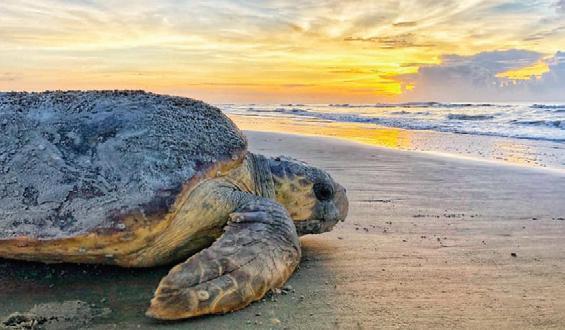
4 minute read
Sea Turtle Season
Loggerhead at dawn on Ossabaw Island (2021). Photo by Caleigh Quick, GADNR about 800 nests a year and we’re now up to about 3,500.”
Like other marine turtles, loggerheads – named for their large heads – crawl ashore on barrier island beaches, dig a hole at the base of the dunes and lay their eggs, usually at night.
Advertisement
To prep for the season, Dodd and staff have been training interns, working with volunteers, partner agencies and organizations, and teaming with DNR’s Law Enforcement Division, all while navigating social distancing and other requirements involving the coronavirus pandemic. Game wardens enforce regulations including the use of turtle excluder devices, or TEDs, in commercial shrimping.
The process followed on Cumberland and Sea islands that morning will be repeated hundreds of times this year. An egg from each nest – less than 1 percent of the average clutch size on the island – was collected for UGA genetic analysis documenting the number and relatedness of loggerheads nesting in Georgia. The nest was then covered with a screen to protect the eggs from predators.
The annual cycle of sea turtles returning to beaches in the Southeast to lay their eggs began early in the morning on May 3, with a nest on Sea Island and four on Cumberland Island. All were found by members of the Georgia Sea Turtle Cooperative, a DNRcoordinated network of about 200 volunteers, researchers and agency employees that patrols beaches daily during nesting season.
The rush for first nest of the year may have been unusual but not the timing. Georgia Sea Turtle Program Coordinator Mark Dodd said first nests “come like clockwork … around the first of May.”
While predicting how the season will go is anyone’s guess, computer modeling of loggerhead nesting in the region points to an average year, according to Dodd, a senior wildlife biologist with the GADNR. “Somewhere around 3,000 to 4,000 nests,” he said.
The Georgia record since comprehensive nesting surveys began on the state’s barrier island beaches in 1989 is 3,950 nests, set in 2019. The count in 2020 dipped to 2,786 nests and last year to 2,493 (plus another seven nests mostly from species other than loggerheads).
The loggerhead population has been increasing at approximately four percent annually since the early 1990s. However, a new population model developed by UGA and the U.S. Geological Survey using nesting and genetics data indicates the population will plateau at current levels for about the next 20 years, its progress hindered by low recruitment during the early 2000s, Dodd said. If current protections remain in place at least through that period, the model suggests loggerhead numbers would then start to increase again, possibly reaching levels not seen since the late 1950s.
Supporting that rebound is the goal of Georgia’s Sea Turtle Cooperative. Working under a federal permit, members mark, monitor and protect all loggerhead nests, plus those of other species that seldom nest in Georgia, such as green and Kemp’s ridley.
The effort not only eases predation and increases the number of young that hatch, the data collected is used to assess loggerhead populations, assess threats and inform management. Cooperators also help with beach management. The program has been in play on Georgia beaches for more than 30 years.
“The cooperative has done a tremendous amount of work, and with a measurable impact,” Dodd said. “We started out averaging
Sea Turtle Tips
To help conserve them: • Minimize beachfront lighting during sea turtle nesting season. Turn off, shield or redirect lights. • When walking the beach at night, don’t use flashlights and flash photography. They can deter turtles from coming ashore to nest or cause them to abort nesting. • If you encounter a sea turtle on the beach, remain quiet, still and at a distance. • Leave turtle tracks undisturbed. Researchers use them to identify the species and mark nests for protection. • Properly dispose of your garbage. Turtles may mistake plastic bags, Styrofoam and trash floating in the water as food. After ingesting trash, it can kill them by clogging their intestines. • Protect beach vegetation: It stabilizes sand and the natural coastline. • When boating, stay alert and avoid turtles. Of the 84 sea turtles found dead or hurt in Georgia last year, 45 percent that could be assessed had suffered injuries consistent with being hit by a boat. Boaters who hit a sea turtle are urged to stand-by and immediately call DNR at 800-2-SAVE-ME (800-272-8363). • Also report any dead or injured sea turtles seen at 800-2728363. (If the turtle is tagged, include the tag color and number in the report if possible.) If an angler hooks or entangles a sea turtle: • Call DNR at 800-2-SAVE-ME (800-272-8363), and … • Keep your hands away from the turtle’s mouth and flippers. • Safely land the turtle using a net or by walking it to shore. Do not lift the turtle by the hook or by pulling on the line. • Leave the hook in place; removing it can cause more damage. (Anglers are encouraged to use non-stainless, barbless hooks when possible.) • Keep the turtle out of direct sunlight and cover it with a damp towel. • If you cannot reach DNR, cut the line as short as possible and release the turtle.










